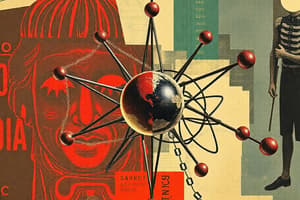Podcast
Questions and Answers
What is the difference between isotopes of the same element?
What is the difference between isotopes of the same element?
Which type of chemical bond involves the sharing of electrons between atoms?
Which type of chemical bond involves the sharing of electrons between atoms?
Which of the following statements accurately describes the periodic table?
Which of the following statements accurately describes the periodic table?
Which type of bond is responsible for the high boiling point of water?
Which type of bond is responsible for the high boiling point of water?
Signup and view all the answers
Which of the following is an example of a chemical reaction?
Which of the following is an example of a chemical reaction?
Signup and view all the answers
Which type of bond is primarily responsible for the conductivity of metals?
Which type of bond is primarily responsible for the conductivity of metals?
Signup and view all the answers
What is the atomic number of an element with 20 protons, 20 neutrons, and 20 electrons?
What is the atomic number of an element with 20 protons, 20 neutrons, and 20 electrons?
Signup and view all the answers
Why do elements in the same group of the periodic table have similar chemical properties?
Why do elements in the same group of the periodic table have similar chemical properties?
Signup and view all the answers
Which of these factors would NOT directly affect the rate of a chemical reaction?
Which of these factors would NOT directly affect the rate of a chemical reaction?
Signup and view all the answers
In a chemical reaction, what is the role of a catalyst?
In a chemical reaction, what is the role of a catalyst?
Signup and view all the answers
Which of the following is NOT a colligative property of a solution?
Which of the following is NOT a colligative property of a solution?
Signup and view all the answers
What distinguishes a strong acid from a weak acid?
What distinguishes a strong acid from a weak acid?
Signup and view all the answers
Which of the following is a true statement about the first law of thermodynamics?
Which of the following is a true statement about the first law of thermodynamics?
Signup and view all the answers
What is the key difference between a solid and a liquid at a molecular level?
What is the key difference between a solid and a liquid at a molecular level?
Signup and view all the answers
Which of these is NOT a common state of matter?
Which of these is NOT a common state of matter?
Signup and view all the answers
Which of the following statements is TRUE about the rate of a chemical reaction?
Which of the following statements is TRUE about the rate of a chemical reaction?
Signup and view all the answers
Flashcards
Reaction Types
Reaction Types
Five main types are synthesis, decomposition, single displacement, double displacement, and combustion.
Factors Influencing Reaction Rate
Factors Influencing Reaction Rate
Temperature, concentration, surface area, and catalysts can affect how fast a reaction occurs.
States of Matter
States of Matter
Matter exists mainly in four states: solid, liquid, gas, and plasma, each with unique properties.
Atom
Atom
Signup and view all the flashcards
Proton
Proton
Signup and view all the flashcards
Isotope
Isotope
Signup and view all the flashcards
Valence Electrons
Valence Electrons
Signup and view all the flashcards
Ionic Bond
Ionic Bond
Signup and view all the flashcards
Covalent Bond
Covalent Bond
Signup and view all the flashcards
Periodic Table
Periodic Table
Signup and view all the flashcards
Chemical Reaction
Chemical Reaction
Signup and view all the flashcards
Study Notes
Atomic Structure
- Atoms are the fundamental building blocks of matter.
- Atoms consist of a nucleus containing protons and neutrons, surrounded by electrons.
- Protons have a positive charge, electrons have a negative charge, and neutrons are neutral.
- The number of protons in an atom defines its atomic number and determines its identity as an element.
- The atomic mass of an atom is approximately equal to the sum of the masses of its protons and neutrons.
- Isotopes are atoms of the same element with the same number of protons but a different number of neutrons.
- Electrons orbit the nucleus in energy levels or shells.
- The arrangement of electrons in different energy levels is described by electron configurations.
- Valence electrons are the electrons in the outermost energy level and are involved in chemical bonding.
Chemical Bonding
- Chemical bonds are forces that hold atoms together to form molecules or compounds.
- Ionic bonds form between a metal and a nonmetal when one atom loses electrons and the other gains them.
- Covalent bonds form between nonmetals when atoms share electrons.
- Metallic bonds form between metal atoms when electrons are delocalized and shared among a lattice of metal ions.
- Hydrogen bonds are a special type of dipole-dipole attraction between a hydrogen atom bonded to a highly electronegative atom (like oxygen or nitrogen) and another electronegative atom.
- These bonds are relatively weak but significant in many biological systems.
Periodic Table
- The periodic table arranges elements based on their atomic number and recurring chemical properties.
- Elements are categorized into groups (vertical columns) and periods (horizontal rows).
- Elements within the same group exhibit similar chemical properties due to similar valence electron configurations.
- Trends in atomic properties (like atomic size, ionization energy, and electronegativity) are observed across periods and groups.
- Metals are typically located on the left side of the periodic table, nonmetals on the right, and metalloids along the dividing line.
Chemical Reactions
- Chemical reactions involve the rearrangement of atoms to form new substances.
- Chemical equations represent these reactions, showing reactants on the left and products on the right.
- Balancing chemical equations ensures that the number of atoms of each element is the same on both sides of the equation.
- Different reaction types exist, including synthesis, decomposition, single displacement, double displacement, and combustion reactions.
- The rate of a chemical reaction can be influenced by factors like temperature, concentration, surface area, and catalysts.
States of Matter
- Matter exists in four fundamental states: solid, liquid, gas, and plasma.
- Solids have a fixed shape and volume due to strong intermolecular forces.
- Liquids have a definite volume but take the shape of their container.
- Gases have no fixed shape or volume and expand to fill their container.
- Plasma is a highly energized state of matter where electrons are separated from atoms, often seen in stars and lightning.
- Changes of state occur when energy is absorbed or released, affecting the intermolecular forces between particles.
Solutions
- Solutions are homogeneous mixtures of two or more substances.
- The solute is the substance being dissolved, and the solvent is the substance doing the dissolving.
- Concentration expresses the amount of solute in a given amount of solution.
- Solutions can be acidic, basic, or neutral, depending on the concentration of hydrogen ions.
- Colligative properties are properties that depend on the concentration of solute particles in a solution, not their identity.
Acids and Bases
- Acids are substances that release hydrogen ions (H+) when dissolved in water.
- Bases are substances that release hydroxide ions (OH-) when dissolved in water.
- The pH scale measures the concentration of hydrogen ions and quantifies the acidity or basicity of a solution.
- Strong acids and bases completely dissociate in water, while weak acids and bases only partially dissociate.
- Neutralization reactions occur when an acid and a base react to form a salt and water.
Thermodynamics
- Thermodynamics describes the energy changes that occur in chemical and physical processes.
- The first law of thermodynamics states that energy cannot be created or destroyed, only transferred or transformed.
- The second law of thermodynamics states that the total entropy of an isolated system can only increase over time.
- The third law of thermodynamics states that the entropy of a perfect crystal at absolute zero is zero.
Kinetics
- Chemical kinetics studies the rates of chemical reactions.
- Reaction rates depend on factors such as reactant concentration, temperature, and presence of catalysts.
- Reaction mechanisms describe the step-by-step process by which a reaction occurs.
- Collision theory explains how reactant particles must collide effectively to react.
Studying That Suits You
Use AI to generate personalized quizzes and flashcards to suit your learning preferences.
Description
This quiz covers key concepts of atomic structure and the nature of chemical bonding. Learn about the constituents of atoms, their charges, and the formation of different types of bonds. Test your knowledge on atom identities, isotopes, and electron configurations.



